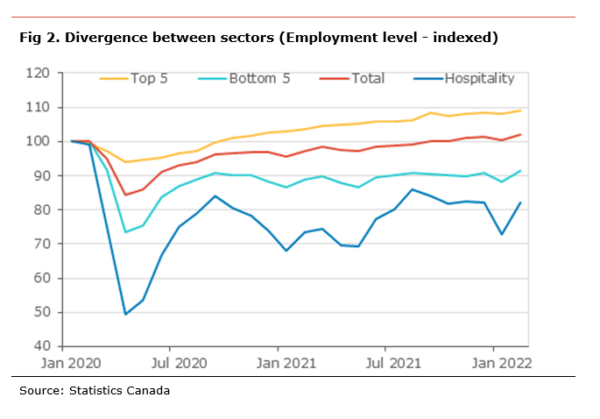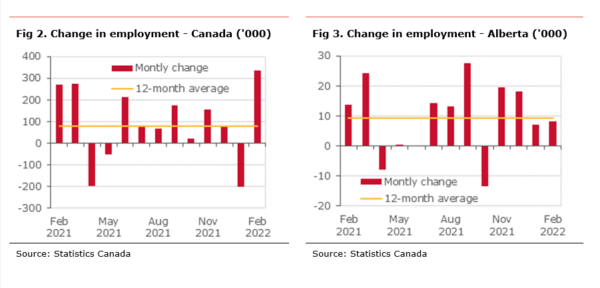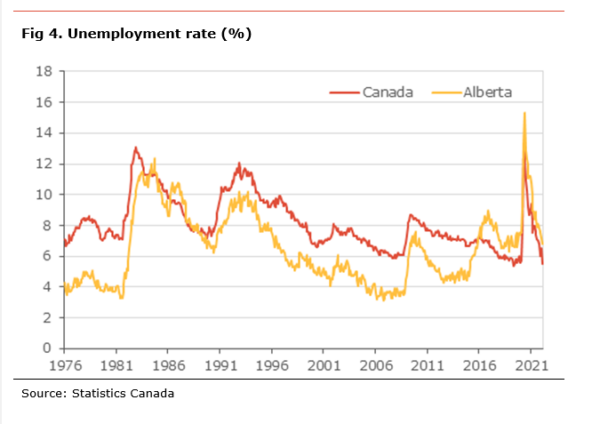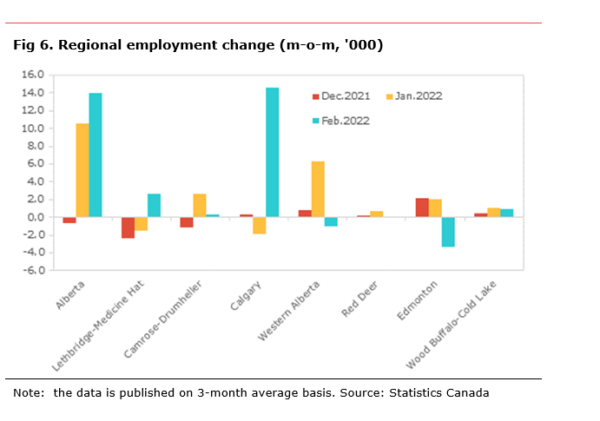Economic insight provided by Alberta Central Chief Economist Charles St-Arnaud. This report includes regional details for Alberta.
Bottom line
Today’s Labour Force Survey data shows that removal of the restrictions to contain the spread of the Omicron led to a sharp reversal in the labour market, with a surge in employment and a drop in the unemployment rate.
The job gains and decline in the unemployment rate shows that the economy remains robust and that the labour market slack is being absorbed rapidly. Therefore, we continue to expect the central bank to increase its policy rate by 25 basis points at the April and June meetings to bring the policy rate to 1.00% by mid-year. However, with the stronger momentum in the labour market and the impact of rising energy and food price on inflation, there is a risk that the BoC could be more aggressive in tightening monetary policy.
Alberta saw another gain in employment in February, but the increase was much more subdued than in the rest of the country. The unemployment rate declined further and is at its lowest since September 2019. However, this is partly the result of workers leaving the labour market, as shown by the decline in the participation rate and the employment rate remaining below their pre-pandemic level. We expect the labour market in the province to continue to improve. The continued record value of oil production in recent months should broadly support the economy and the labour market.
Employment surged by 336.6k in February as restrictions to slow the spread of the Omicron variant were removed. This increase more than reverse the drop in employment of 200k seen in January. Despite the significant job losses, the level of employment remains slightly above (+0.2%). As a result of the rise in employment, the unemployment rate dropped to 5.5% from 6.5%, its lowest level since June 2019. The participation rate improved 65.4% from 65.0%, as workers left the sidelines looking for work. The employment rate, the share of the population holding a job, increased to 61.8%, its highest since the start of pandemic and only marginally below its pre-COVID level.
The details show that the job gains in February were in full-time (+121.5k) and part-time jobs (+215k). In addition, almost all of the increase in employment was in the private sector (+347k), while job gains in the public sector were more modest (+7.9k) and there were some losses in self-employed (-18.6k).
On an industrial level, the increase in employment was mainly in the service sector (+293k) and also increased in the goods-producing sector (+55k).
The gains in the good-producing sector show that the gains were mostly in construction (+55k). This sector has been responsible for most of the job gains in the goods-producting sector for the past three months (95k out of 110k). There were also smaller increases natural resources (+3.5k) and agriculture (+3k), while employment was mostly unchanged in manufacturing (+1k) and utilities (-0.5k).
The surge in the service industry was relatively broad-based and due to the removal of restrictions on economic activity, with sizeable gains in accommodation and food services (+114k), information, culture and recreation (+73k), professional, scientific and technical (+47k) and trade (+38k). There were some job losse in public administration (-18k)
Despite the overall level of employment being above its pre-COVID level, only 11 out of 16 industries have a level of employment above their pre-pandemic level. These sectors are natural resources, utilities, construction, manufacturing, trade, finance, insurance and real estate, professional, scientific and technical services, education, health care, information, culture and recreation, and public administration. Nevertheless, some sectors continue to lag behind the rest of the economy. Despite the strong gains in February, accommodation and food services remains one of the worst-performing industry since the pandemic (17% below its pre-pandemic level). Employment in the agriculture sector is currently almost 20% below its pre-COVID-19 level, the worst performing industry.
Implications for Alberta
In Alberta, employment increased by 8.2k in February. The job gais in the province were more budued than nationally in part due to the lack of job losses in January. The level of employment is 1.8% (or 42k) above its pre-COVID level. The unemployment rate dropped to 6.8%, lower than its pre-pandemic level and the lowest since September 2019. However, the decline in the employment rate can be partly attributed to a lower participation rate, which eased to 69.4% from 64.6%. Nevertheless, the employment rate, the share of the population holding a job, improved to 64.7% from 64.5%, still slightly below its pre-pandemci level.
The job gains in Alberta were entirely in the service sector (+9k), while there were some small losses in the goods-producing sector (-1k). In the goods-producing sector, declines in manufacturing (-3k) and utilities (-1.5k) were partly offset by gains in agriculture (+1k), natural resources (+1k) and construction (+0.5k).
The job performance in the service sector was mixed. Most of the job gains were in professional, technical and scientific services (+9.5k), Education (+5k), information, culture and recreation (+5k), accommodation and food services (+4k) and trade (+4k). However, these increases were partly offset by losses in transportation and warehousing (-12k), finance, insurance and real estate (-5k), public administration (-3.5k) and health care (-3k).
Despite continued job gains and overall employment being above its pre-COVID level, only 9 out of 16 industries have a level of employment above their pre-pandemic level. Those industries are: natural resources, construction, trade, transport and warehousing, finance, insurance and real estate, professional, technical and scientific, education, health care and public administration. Employment in the accommodation and food services sector, the worst-hit industry, remains almost 25% below its pre-COVID-19 level, underperforming the rest of the country.
On a regional basis, the data is published on a three-month average basis (see table below). Over the past three months, the province gained 14.0k jobs, increasing in most regions, except in Edmonton (-4.2k), Western Alberta (-1.2k) and Camrose-Drumheller (-0.4k). Employment rose the most in Calgary (+10.4k), Lethbridge-Medicine Hat (+1.9k), Red Deer (+0.5k) and Wood Buffalo-Cold Lake (+0.5k).
Compared to the pre-pandemic levels, employment is the lowest in Camrose-Drumheller (-9.8%), Lethbridge-Medicine Hat (-4.5%), and Wood Buffalo-Cold Lake (-1.0%). Conversely, Calgary (+3.0%), Edmonton (+2.3%), Red Deer (+1.2%), and Western Alberta (+0.7%) are the regions where employment is above their pre-pandemic level.
The unemployment rate for the province as a whole declined to 7.6% from 7.8%. The decrease in the unemployment rate was broad-based, with the biggest drops in Wood Buffalo-Cold Lake (-0.7pp), Calgary (-0.6pp), Lethbridge-Medicine Hat (+0.6pp) and Camrose-Drumheller (-0.4pp). The unemployment rate is the highest in Calgary (8.2%), Red Deer (8.0%), Edmonton (7.3%) and Wood Buffalo-Cold Lake (7.3%). It is the lowest in Western Alberta (6.1%), Camrose-Drumheller (6.3%), and Lethbridge-Medicine Hat (6.6%).
The employment rate for Alberta improved to 63.9% from 63.4%. It improved in Lethbridge-Medicine Hat (+1.1pp), Calgary (+0.9pp), and Wood Buffalo-Cold Lake (+0.8pp) but deteriorated in Western Alberta (-0.5pp) and Edmonton (-0.3pp).








Please note: All the numbers are expressed as three-month average of the non-seasonally adjusted number.
Independent Opinion
The views and opinions expressed in this publication are solely and independently those of the author and do not necessarily reflect the views and opinions of any organization or person in any way affiliated with the author including, without limitation, any current or past employers of the author. While reasonable effort was taken to ensure the information and analysis in this publication is accurate, it has been prepared solely for general informational purposes. There are no warranties or representations being provided with respect to the accuracy and completeness of the content in this publication. Nothing in this publication should be construed as providing professional advice on the matters discussed. The author does not assume any liability arising from any form of reliance on this publication.
Alberta Central member credit unions can download a copy of this report in the Members Area here.